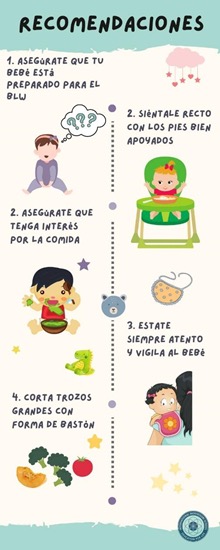What is Baby-lead Weaning and why choose this method of complementary feeding
What is Baby-led weaning?
Baby-Led Weaning (BLW) is a method of complementary feeding to breastfeeding, where the baby takes food with his hands and takes it to his mouth autonomously. You can introduce this technique between the first 4 – 6 months, when your baby begins to use his tongue to chew, and will provide the ideal food complement to breast milk or formula during the first 12 months.
6 advantages why Baby-Lead Weaning can be important in the development of your baby
The baby will become one more at the table
Baby Led-Weaning allows your baby to be present at every meal to integrate and develop a good family bond. Through imitation, the baby can begin to learn as a family to relate to food in a fun and relaxed way.
Helps you develop a more tolerant and varied palate
Introducing your baby to a variety of flavors, textures, smells, etc., allows him to have a healthier relationship with food and prevents him from rejecting some foods because he does not have to start eating them out of obligation.
Develops fundamental cognitive processes
When your baby begins to experiment with food, he needs to smell it, squish it, pinch it, and play with it. This helps him develop good hand-eye coordination between what he sees and what he puts in his mouth. It also helps you build brain connections, control the amount of food you eat, and develop an enjoyable experience with food.
Strengthens the jaw and mouth muscles
The process of moving food around the mouth, chewing it, and swallowing it strengthens the jaw and mouth musculature, which is also important for neural stimulation and speech development.
Learn to be autonomous and independent
Because they learn to eat on their own, little by little the little ones become independent and autonomous beings, both when eating and in any of their daily activities.
Allows you to develop good eating habits
Around 18% of children in Spain suffer from childhood obesity. One of the great advantages of Baby-Lead Weaning is that your baby learns to control his appetite and identify when he is hungry.
How to introduce Baby-Led Weaning into your baby’s meals
- To know if the time has come to introduce complementary feeding, you should look at how the baby reacts when you put food in his mouth: if he sticks out his tongue and expels it, he is not ready yet. If he no longer exhibits this behavior, you can now start introducing Baby-Led Weaning!
- Your posture is key: the baby’s trunk has to be straight and the feet supported. You should see if he is interested in the food he sees around him.
- It is also important to pay attention to him to notice if he is retching because he is learning to swallow, which is a normal process. In case you detect that he is choking, help him remove the food from his mouth.
- From 9 months, you can start giving him smaller pieces of food, such as in the shape of a stick. The baby should be able to chew them with their gums, so one way to tell if a piece is suitable for the baby is to try to easily crush it with your fingers. If you can do it, it is suitable for the baby
- At first, start with one food and, when you master it, introduce another one progressively until you even reach complete dishes.

What should you take into account?
Firstly, it is essential that you observe your baby and see in what process of his development he is. This way, you will never force him to eat if he doesn’t feel ready or doesn’t give any indication that he wants to experiment with food.
Sometimes parents are afraid that the baby will go hungry or choke or do not feel confident to introduce Baby-Led Weaning. In this case, it is advisable to obtain prior advice in order to enjoy all its benefits. If you have any questions or need to learn more about this method, contact us to find out more and see how our students enjoy it every day.









